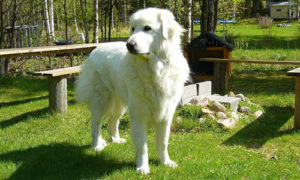
The name Boerboel, which is (pronounced BUR-bul), means “farmer’s dog.” It is a well-known fact that when Jan Van Riebeeck and company arrived in South Africa in 1652 to set up a trading post (Cape Town) for the Dutch East India Company, they brought with them their Bullenbitjers for protection.

Other colonists brought their large dogs for protection purposes as well. Later on, Bulldog and Mastiff breeds arrived with British settlers in the 1800s. These dogs all interbred and spread further north during the Great Trek at the beginning of 1838.
These dogs interbred with native African dogs, and the Rhodesian Ridgeback is believed to have had a role. Farmers used Boerboel for protection against dangerous animals, and fellow humans in the sporadically settled regions, which led to large numbers of them kept on farms.
The Boerboel’s daily duties included guarding different livestock, controlling oxen, or accompanying the farmer on various chores. It is a well-known fact that one Boerboel can kill a leopard; unfortunately, contrary to popular belief, a single Boerboel cannot kill a lion.
The Diamond mining company De Beers brought in Bullmastiffs to guard their South African mines. This event marked the beginning of mastiffs entering the gene pool of the Boerboel.
During the 1980s, two breed enthusiasts searched Africa for purebred Boerboel dogs, eventually finding 250 and selecting 72 for registration. As a result, the breed quickly spread throughout the world. However, the dog is banned in at least one country as a fighting dog. Thankfully, the AKC registered it as a member of the Working group in 2015.
Boerboel Breed Facts
Popularity: rare
Family: Mastiff
Origin: South Africa
Date of Origin: 1800s
Original role: Farm guardian
Today’s function: Guardian, companion
Other names: None
Weight: Male: 141 – 180 pounds; Female: 101 – 130 pounds
Height: Male: 25 – 27 inches; Female: 23 – 25 inches
The Boerboel is a large and muscular dog showing strength and agility in motion. Bred to protect people, property, and livestock, the Boerboel needs to be strong enough to overpower, all while being agile enough to avoid the many dangerous African animals.

The Boerboel needs to be intelligent as well. It is crucial that it can recognize danger, all while being cautious enough to avoid it and courageous enough to face it. The breed’s jaws are powerful, and its coat is short and dense.
For added protection, the skin is thick and loose. It is well pigmented to protect against the African sun. The dog is somewhat longer than it is tall, with commanding free-flowing movement.
Temperament and Upkeep
This dog is known for being extremely protective of people and property. It is an intelligent and strong-willed working dog. However, novices should beware; this is not a dog for the first time dog owner. They dislike strangers, though; they’re incredibly affectionate with people they know. It is also essential to properly train and socialize them from an early age to prevent aggression and other behavioral issues from becoming prevalent.
Boerboels require a standard level of activity. You can satisfy this breeds exercise needs with a long walk or jogging endeavor. However, this breed will not do well with dog parks. Also, they love challenging sports, such as tracking. Taking care of the coat is a minimal undertaking; it consists of an occasional bath or brushing. They’re also well equipped to handle a moderate climate.
Unfortunately, Boerboel dogs are susceptible to CHD and elbow dysplasia. Also, minor health concerns include entropion and ectropion. Although not typical, epilepsy is occasionally seen in this breed as well. Boerboel breeders recommend that owners test for hip, eye, and heart problems. Remember, this is a rare breed; make sure you find reputable breeders with Boerboel puppies for sale. A simple search engine search can help you on the right track.





